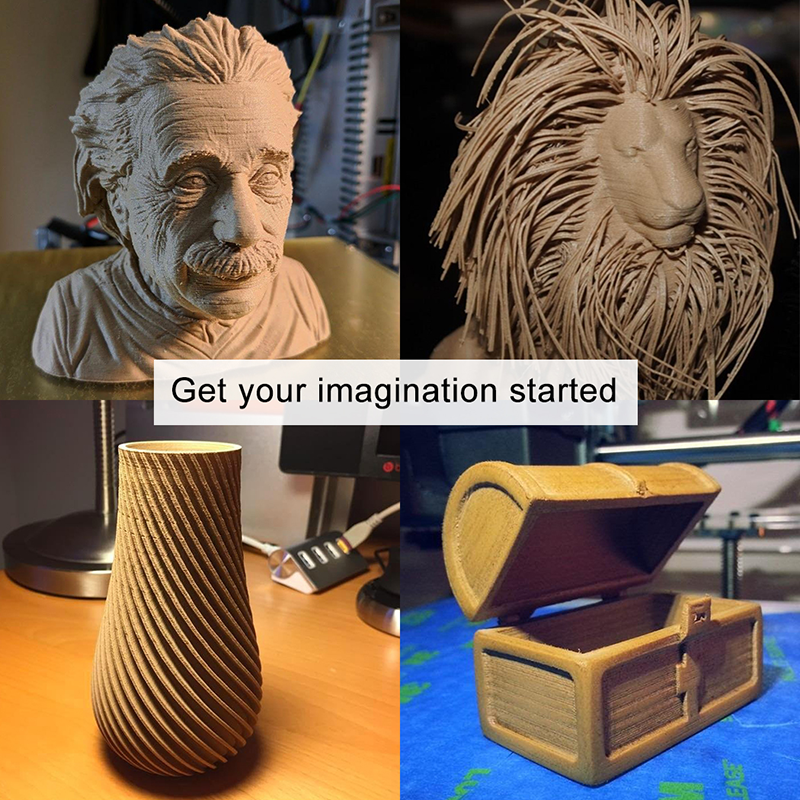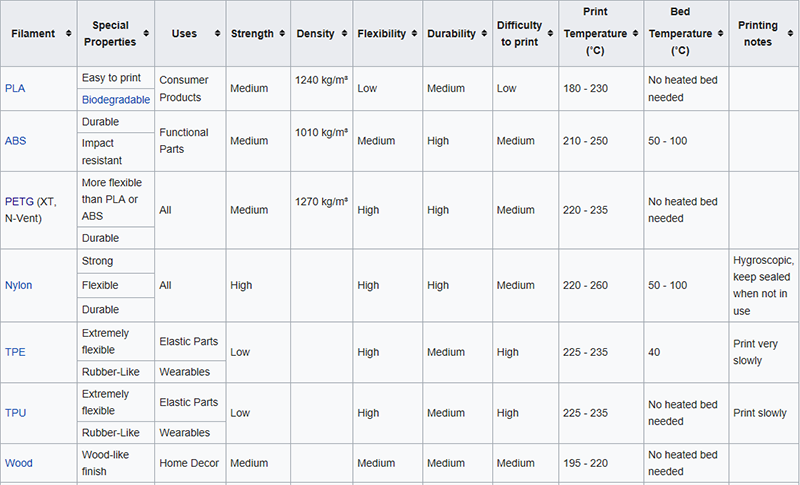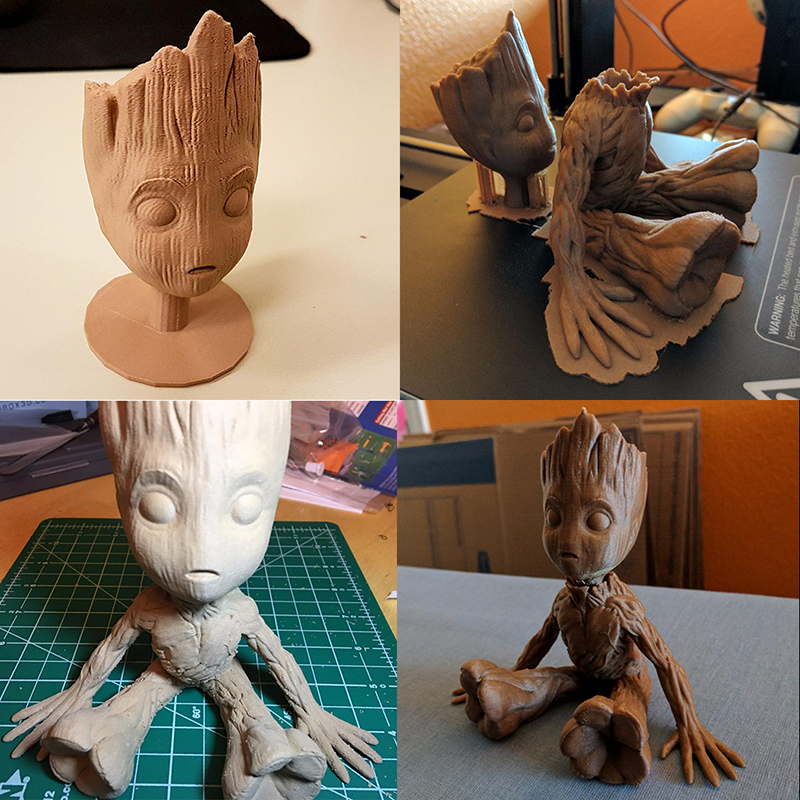3D printing refers to any of various processes in which material is built or solidified through computer control to create 3D objects. 3D printing is applied in both additive manufacturing and rapid prototyping. 3D prints can take almost any shape or geometry and typically are produced by use of digital model data from a 3D model or other electronic data source like an Additive Manufacturing File (AFM) (normally in sequential layers).
There are a variety of 3D printing technologies, such as fused deposit modeling (FDM) or stereo-lithography (SLA). Therefore, unlike material removed from a stock in the traditional machining process, 3D printing or additive manufacturing creates 3D objects from AMF files or CAD models, usually by adding material in sequential layers.
Today, let’s have an overview of the common 3D printer filament types.
(An Overview Of The Common 3D Printer Filament Types, Source: Wikipedia)
PLA Filament
PLA (Polylactic Acid) is one of the two most commonly used 3D printer filaments, with the other being ABS filament. It’s the “default” recommended material for many desktop 3D printers, and with good attributes: PLA has a wide range of printing applications with the feature of being both odorless and low-warp, and doesn’t require a heated bed. PLA is also one of the more environmental-friendly 3D printer materials available, usually made from renewable resources (corn-starch), and requires less energy to process compared with conventional (petroleum-based) plastics. Moreover, PLA 3D printer filament is available in various colors in 1.75mm.
PLA 3D Printer Filament Features:
- PLA filament is a stiff but brittle 3D printing material;
- Best used for prototypes, desktop toys, cosmetic prints, low-stress applications;
- Best 3D printing material for beginners due to great ease of printing and low-warp.
ABS Filament
ABS (Acrylonitrile Butadiene Styrene) is the other commonly used 3D printer filament, best used for creating durable parts that need to bear higher temperatures. ABS filament is less brittle and more ductile. When using ABS filament for 3D printing, a heated printing surface is suggested due to the fact that ABS plastic will contract when cooled resulting in warped parts. ABS 3D printer filament is also available in multiple colors in 1.75mm.
ABS 3D Printer Filament Features:
- ABS filament is a tough, ductile material with heat tolerance and wear resistance;
- Best used for functional parts such as interlocking parts like gears, parts exposed to heat and UV like car cup holders and prototypes, etc.
- Broad selection of method for excellent post-processing.
PETG Filament
PETG (Polyethylene Terephthalate) is an industrial strength filament with several great merits. Simply put, it combines the ease of use of PLA filament with the durability and toughness of ABS filament. PETG has much higher strength than PLA, and it is approved by FDA for food containers and tools used for food consumption. Different from ABS filament, PETG rarely warps and produces no fumes or odors when being printed. It’s famous for its clarity and is very good at bridging as well. PETG 3D printer filament is also available in 1.75mm with various colors.
PETG 3D Printer Filament Features:
- PETG is a flexible and durable printing material with a glossy finish and has good resistance to heat;
- Best used for mechanical parts and snap fit enclosures;
- Sticks amazingly well to blue painters tape.
TPE Filament
TPE (Thermoplastic Elastomer) is a flexible printing material which feels and performs a lot like flexible rubber. You can use it to build parts that can blend or must flex to fit the surroundings: belts, stoppers, phone cases, springs, etc. Because of its ultra flexibility, much slower printing speeds must be adopted to prevent the filament from binding in the extruder. TPE 3D printer filament is also available in multiple colors in 1.75mm.
TPE 3D Printer Filament Features:
- TPE filament builds rubbery, elastic and impact resistant parts;
- Best used for belts, stoppers, phone cases, springs, bumpers, etc.
- The less infill you use, the more flexible your final print will be.
TPU Filament
TPU (Thermoplastic Polyurethane) is an elastic, abrasion-resistant and grease-resistant material having a shore hardness of 95A. TPU has various applications such as power tools, automotive instrument clusters, caster wheels, medical devices, footwear, drive belts, and a variety of extruded film, sheet and profile applications. It is commonly used in cellphone cases as well. TPU 3D printer filament is available in 1.75mm with multiple colors.
TPU 3D printer Filament Features:
- TPU filament builds rubbery, elastic and impact resistant parts;
- Best used for power tools, automotive instrument clusters, caster wheels, medical devices, phone cases, drive belts, footwear, etc.
- The less infill you use, the more flexible your final print will be.
Wood Filament
Wood filament is a wood-like 3D printing material that renders 3D printed objects the look and feel of fiberboard. It endows parts with other wood-like properties, such as the capability to be cut, painted and sanded. With woodfill or timberfill, it gives your final prints the color and texture of real wood. Due to these organic fills, you should be careful of too high of a temperature, as this will cause the wood to burn, thus making your finished print dark-colored. You’d better remove the filament from the extruder once a print is finished, otherwise the filament may start to burn in the nozzle and begin to clog it. Wood 3D printer filament is available in 1.75mm spooled rolls.
Wood 3D Printer Filament Features:
- Wood filament looks and feels like real wood, giving your 3D prints a wood-like finish;
- Best used for wooden busts, tikis, benchy, or sculptures, etc.
- Different extruder temperatures create different colors: the hotter temperature, the darker color.
Let’s call it a day. Each filament is unique in its own way with its merits and demerits. After reading through this article, we hope you’ll have a basic understanding of the common 3D printer filament types used for 3D printing and pay special attention to different printing parameters when using them for your 3D printing projects!
Post time: Nov-01-2018









